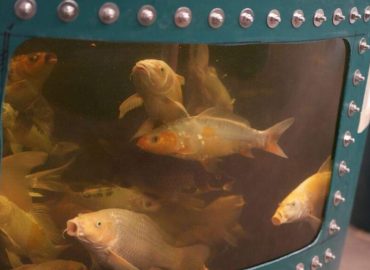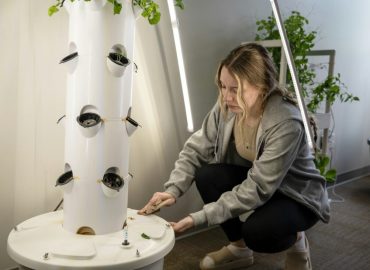Ontario Vertical Farming Growing
Vertical farming allows year-round growing
Technology a boon to techniques that can provide local supplies and greater food sovereignty
Ontario Vertical Farming Growing | Leah Gerber |
IMAGE: Cheryl Verbiski and Cesar Cappa of GoodLeaf Farms with rows of microgreens growing in the company’s vertical farm in Guelph. Leah Gerber
A way to extend a short growing season, vertical farming is gaining ground in Ontario.
Vertical farming is a way to grow food within a controlled environment. It’s similar to producing food in a greenhouse, but the light is supplied by electric light sources, and supplies of carbon dioxide and water are controlled.
It’s the next level of indoor farming, according to Thomas Graham, a professor of controlled environment agriculture at the School of Environmental Science at the University of Guelph.
“It’s still a nascent industry,” said Graham. “Its roots do go back, probably 30 years now. But it’s only really been in the last 10, say, or maybe a little bit longer that it’s really started to become a potentially viable contributor to our food supply.”
He says the recent growth in the industry is mainly due to developments in LED lighting.
Before LED lights, high-pressure sodium or metal halide lights were used, but they were too hot and used too much power for farming, he says.
The Ontario Ministry Of Agriculture, Food and Rural Affairs (OMAFRA) estimates there are currently 30 to 40 independent vertical farms in the province.
Guelph-based GoodLeaf is one of the largest vertical farms in Canada. The company produces microgreens, including mustard, pea shoots, arugula, radish and broccoli as well as baby spinach and arugula and lettuce.
The current Guelph location has capacity to produce one million pounds of greens per year, says Cheryl Verbiski, the vice president, commercial for the company. The company is expanding operations to new farms in Montreal and Calgary, and she says these farms are planned to be double the size of the Guelph location.
Everything in the Good Leaf facility is tightly controlled. At the tap of a button, Cesar Cappa, the horticulture technical specialist, knows exactly what is growing, how long it’s been growing, what stage of growth it is in, and when it will be harvested.
The light, the medium the plants are grown in, air and water are all tightly controlled to produce fresh greens in a matter of days.
Verbiski says one of her biggest challenges is getting stores and restaurants to realize they can order how many greens they need almost on demand, as GoodLeaf staff can seed exactly what their clients need.
Graham, Verbiski and Cappa say vertical farms can help solve the puzzle that is improving Ontario’s food sovereignty.
“The COVID pandemic, that really did lay bare the fragility of our food supply. If borders get closed or one country’s suffering more than the others, the supply chain, as we found out, is incredibly vulnerable,” said Graham.
“The only way to [grow greens] in Ontario for 365 days a year is controlled-environment agriculture,” he said. “If we want to be more self-sufficient or strengthen those food supply chains by producing domestically, the only way we can do it is indoors all year.”
Verbiski and Cappa agree.
“What we need is for Canadians to continue to support this now, because there will be a day, as we’re starting to see in California, when the inconsistency of what we’re getting in California is a huge problem,” said Verbiksi. “To support Canadian-grown agriculture, whether it’s vertically farmed or any format, is important.”
“OMAFRA recognizes that research and innovation are critical to the success of Ontario’s agri-food sector, playing a vital role in food security. The province recently announced its Grow Ontario Strategy, which outlines the ministry’s plan to strengthen the agri-food sector, ensure an efficient, reliable and responsive food supply, and address any potential vulnerabilities through new innovations,” said Connie Osborne, a spokesperson for the ministry.
She said the province provided more than $350,000 to vertical farming research projects.
Graham says vertical farming has potential to be a sustainable, closed-loop system, but it’s not there yet. One of the main downsides is the use of energy to power lights, and handling the extra biomass left over.
Verbiski and Cappa say their leftover biomass, including their growing medium, peat moss and the stems of their greens, are sent to the landscaping industry where it is repurposed for an outdoor growing medium.
Another input needed is carbon dioxide. Plants use carbon dioxide to grow and take it from the air. Vertical farming staff need to buy and input carbon dioxide into their facilities.
Graham works on solving these sustainability problems in his capacity as a researcher, partnering with NASA and the Deep Space Food Challenge, which aims to, “create novel food production technologies or systems that require minimal inputs and maximize safe, nutritious and palatable food outputs for long-duration space missions, and which have potential to benefit people on Earth,” according to its website.
Sustainability is a pillar of any research about growing food in space, said Graham.
“There is no waste in space, primarily because it’s really expensive to get stuff there and it’s hard to get stuff there,” said Graham, adding any growing methods in space must be closed-loop systems because of the cost.
He notes the resulting technology and methods can be utilized on Earth to make vertical farming more functional and sustainable.
Back on Earth, where can vertical farms be placed? Almost anywhere, says Graham.
They can be smaller productions like Noki farms, which is an indoor mushroom farm located in the Old Quebec Street Shoppes in downtown Guelph, or in backyard shipping containers, or larger sites like GoodLeaf, which exists in an industrial complex on the edge of Guelph.
This flexibility of size and space usage is one of vertical farming’s best features, he suggests.
“It allows a ‘family farm’ to be feasible, you don’t need to come up with millions of dollars to buy the land and work the land and buy the tractors and all that. You can start a family farm in a shipping container or two, or small warehouse space. Maybe we need to change the definition of family farm.”
That said, Graham notes that vertical farms are complementary to traditional farms, and could never replace them.
“You’re not going to grow the staples and feed all of Ontario indoors.”
Original Article: https://www.observerxtra.com/vertical-farming-allows-year-round-growing/
The post Ontario Vertical Farming Growing appeared first on GROZINE.



